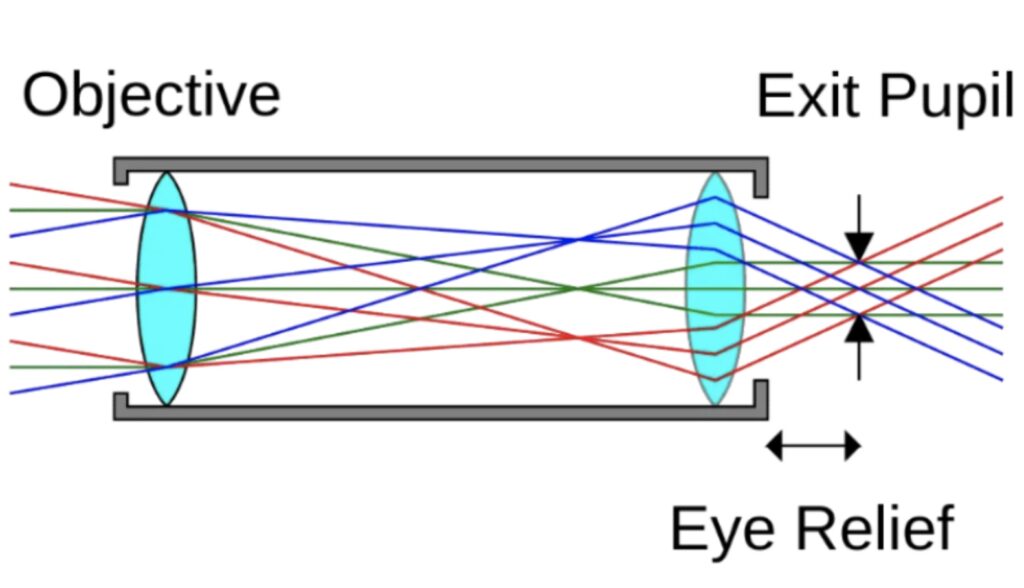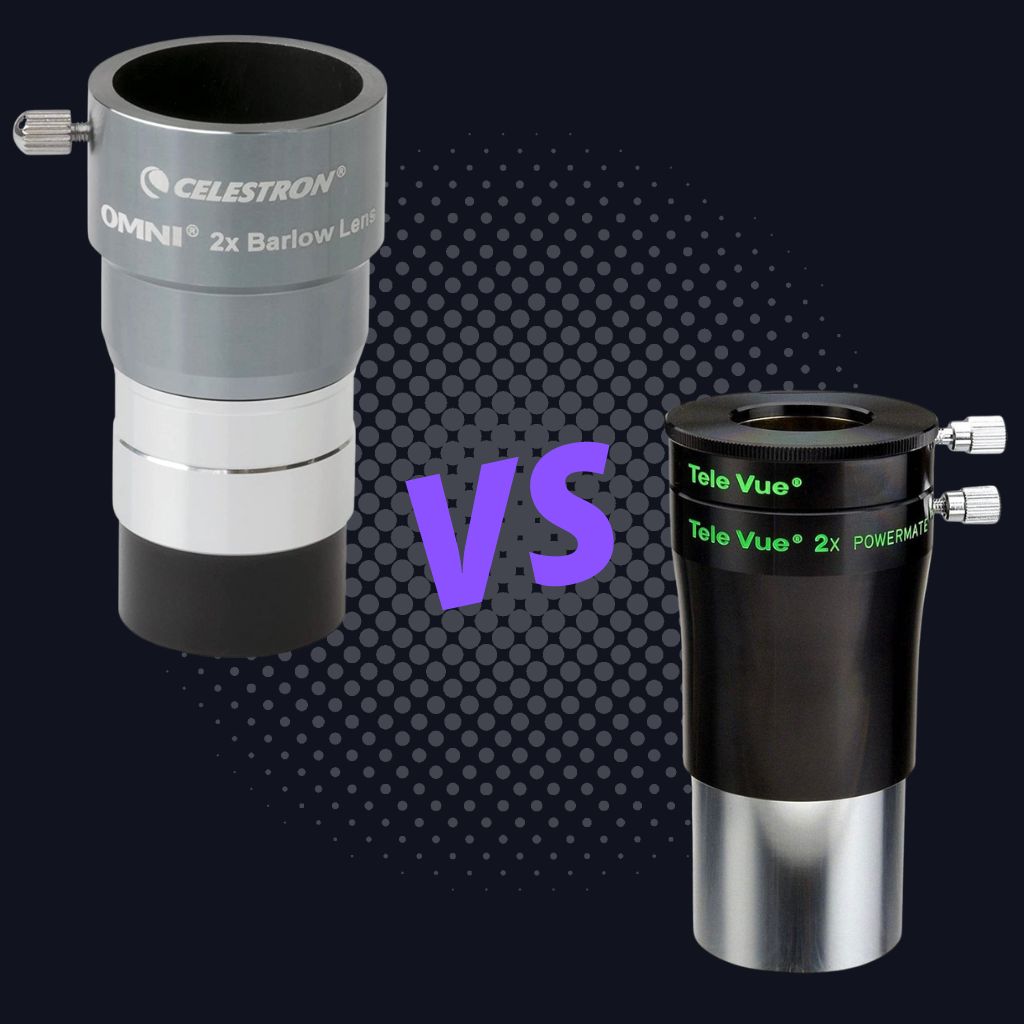This site contains affiliate links to products. I may receive a commission for purchases made through these links.
Are you looking for ways to get the best views of telescopic images of celestial bodies? One recommendation is to use a Barlow lens or a similar optical tool called Powermate. But what exactly are these devices, and what is the difference between them?
The Barlow lens comprises 2 or 3 optical elements (negative doublet). The configuration results in diverging rays that extend the eye relief and cause vignetting. The Powermate comprises 4 optical elements (negative doublet and positive doublet). This configuration corrects the eye-relief issue, providing pure magnification.
Read on to learn more about the benefits of these optical devices and how they let you get clearer images when using your telescope.
What is a Barlow’s lens?
The Barlow lens is a diverging lens used in series with other optics in an optical system to increase the system’s effective focal length (as perceived by other components after the lens in the system). Increasing the system’s focal length increases magnification, so a Barlow lens is used in a telescope to increase the scope’s magnification.
The Barlow lens is named after Peter Barlow, the English optician and mathematician who invented the earliest version of the optical device in 1833.
In a telescope, the Barlow lens reduces the convergence of the light cone heading toward the eyepiece. By doing so, the Barlow lens extends your telescope’s focal length.
A telescope’s magnification equals its focal length divided by the eyepiece focal length. Increasing a telescope’s focal length increases its magnification. The Barlow does this to help your telescope achieve higher magnification for a given eyepiece.
For this reason, the Barlows are considered focal extenders for objectives or focal reducers for eyepieces.
You may also like: Barlow Lenses: Definition, Benefits, and How to Use Them
What is a Barlow lens used for?
A Barlow lens is a go-to tool for planetary and moon observation. Since our solar system’s objects are very tiny in the sky, you need a higher magnification telescope that effectively enlarges them. Here’s where a Barlow lens becomes necessary.
Barlow lenses are also used to achieve the prime focus with DSLR (digital single-lens reflex) for astrophotography.
To enjoy astrophotography without breaking the bank, check out this article: Budget Astrophotography with a telescope and DSLR camera.
Types of Barlow lens multipliers
Barlows are available in many options. 1.5x – 3x Barlow lenses are popular. There are also 5x magnification Barlows, but these are rare.
The Barlow lens multiplies your focal length by its magnifying power. For example, a 2x Barlow doubles the telescope’s focal length, while a 3x Barlow triples the focal length. Thus, a Barlow lens makes a short focal length telescope give you high-power viewing.
To choose the right multiplier, check my article about the best Barlow lenses, where I go deeper into this topic.
Limitation of the Barlow lens
Many Barlows have two optical elements (negative doublet), while a few others have three. The negative power lens of the Barlows is its bane.
While the optical configuration will magnify the image, the negative element diverges the rays coming out of the Barlow. For this reason, the exit pupil position moves further out, extending the eye relief.
Eye relief is the distance from the last surface of your telescope within which you can obtain the full viewing angle. Increasing the eye-relief results in vignetting with many eyepieces, especially with long focal length eyepieces.
While vignetting is a serious issue with long focal length eyepieces, it is minimal in medium focal length eyepieces and negligible in short focal length eyepieces.

Thus, while Barlow lenses provide effective magnification, they diverge the rays coming out to extend the eye relief and possibly cause vignetting (a reduction of image brightness at the edges of the field of view).
The Powermate lens was developed as an optical device to solve this problem by providing magnification without diverging the rays.
What is Powermate?
A Powermate is basically a Barlow lens with an additional optical element (positive doublet) to correct the issue of “rays diverging when they come out of the lens and pushing the pupil exit further out.”
The Powermate comprises four elements – a negative doublet and a positive “pupil-correcting” doublet.
The positive element of Powermate picks up where the Barlow concept cannot go further. It allows the optical device to provide the magnifying function of a Barlow without the limitations that plague Barlows.
The superiority of Powermate
Powermate uses the positive doublet to redirect field rays. It restores the field rays to their original direction. Since light rays do not diverge when they come out from the lens, the exit pupil is the same as without the Powermate. The result is pure magnification increase with no vignette.
Thus, the Powermate is “invisible” in the light train of the telescope. Putting the eyepiece in the Powermate is like putting it directly into your focuser.
When using the Powermate, you don’t have to refocus each time you change the eyepiece. Also, some say the image quality is better than the Barlow lens.
Limitation of Powermate
However, the Powermate is usually tall. So, it extends more than the Barlow lens. Powermate is more expensive too, and sometimes it is not worth the money for the particular telescope and setup.
What is the difference between a Powermate and a Barlow?
A Barlow lens and a Powermate are both devices used in optical systems to increase magnification. While they look the same, there is a difference between them.
A Powermate equals a Barlow plus a pupil-correcting positive doublet.
A Barlow has just a negative doublet for the magnification function. But a Powermate has a negative doublet and a positive doublet, with the negative element providing magnification and the positive element ensuring there are no external knock-on effects.
The knock-on effect of magnification using a Barlow lens is that light rays diverge when coming out of the device, increasing eye relief. This may cause vignette and degrade long focus eyepieces.
However, thanks to the pupil-correcting positive field lens of a Powermate, light rays coming out of the optical device have the same angle as they did going in. This ensures that the eye relief stays where the eyepiece designer intended.
Importantly, there will be no vignetting. So, a Powermate improves image edge sharpness for a wide-angle eyepiece that uses a fast focal ratio telescope.
Barlows are shorter than Powermates. So, a Barlow extends from your focuser less than a Powermate.
Also, when using a Barlow, you’ll need to refocus whenever you change your eyepiece. However, some high-quality eyepieces require only a bit of refocusing after changing the eyepiece.
The differences between a Barlow and a Powermate can be summarized as below:
| Barlow | Powermate |
| -Comprises of 2 or 3 lenses -The lenses have only a negative element -Light rays coming out of the device diverge -It increases the eye relief (which is good for glasses users) -It may cause vignetting -It has a compact size -It requires you to refocus every time you change your eyepiece | -Comprises of 4 lenses -It has a negative element and a positive element -Light rays coming out have the same angle as they go in -It does not affect eye relief -It doesn’t cause vignetting -It is relatively taller, so will extend considerably from your focuser -It does not require refocusing every time you change your eyepiece |
Benefits of Barlow lens
Using a Barlow comes with some benefits.
- The Barlow is cost-effective: A Barlow is one of the easiest and cheapest ways to increase the magnification of your telescope. They are cheap and easy to put in place.
- A Barlow doubles your eyepiece collection: Having a Barlow also means you’ll spend less on eyepieces. Instead of buying six eyepieces, you’ll only need to buy three eyepieces and a Barlow.
- Barlows give more comfortable eye relief: The diverging rays leaving a Barlow push the exit pupil further out. This extends eye relief, which may make looking through the eyepiece more comfortable, especially for eyeglass wearers.
Benefits of Powermate
Using a Powermate comes with the following benefits:
- Powermate gives a telecentric operation: Powermate ensures that field rays leave parallel to the optical axis instead of coming out diverging as with the Barlow concept.
- The Powermate eliminates the issues associated with using the Barlow: Powermate checks all issues associated with rays diverging as they come out of the device. Thus, Powermate minimizes or eliminates pupil movement, vignetting, and edge field aberrations.
- Powermates are parfocal: The Powermate stays in focus even when you change your eyepiece. So you won’t need to refocus every time you change your eyepiece. Except for the 5x model, the Powermate has almost constant magnification. These make the Powermate more flexible in imaging and visualization on all eyepieces and scopes.
Powermate vs Barlow: Which one is better for increasing magnification?
A Barlow and Powermate are not different in terms of magnifying power. However, the Powermate trumps the Barlow in optical performance because it magnifies target objects while eliminating aberrations common with Barlows.
The Barlow and Powermate lenses increase a telescope’s focal length, effectively increasing its magnification for a given eyepiece. A 2x Barlow or Powermate will make a 20mm eyepiece act like a 10mm piece, effectively doubling your magnification.
However, while a Powermate does not outperform a Barlow in terms of magnification, it has higher optical performance.
The corrector lens in the Powermate eliminates aberrations common with Barlows. It also makes the Powermate parfocal so that you can spend less time focusing on your eyepieces and more time exploring the heavens.
Know that if you already have a Barlow and do not feel like investing in a Powermate, you can still tackle the “diverging light rays” limitation of Barlows. You can do this by using a Panoptic-Barlow interface lens.
Best Barlow lens for your telescope
Some of the best Barlows for telescopes are:
Celestron X-Cel LX Series Eyepiece – 1.25 inch
The Celestron X-Cel LX Series is a high-quality Barlow optimized for planetary viewing. It offers a 60-degree field of view using a six-element fully multi-coated lens system. It offers sharp images with high contrast. The barrel holds standard 1.25” eyepieces and is threaded to accept filters.
This Celestron Barlow scores high on ergonomics. It features a threaded rubber grip, offering a non-slip grip even when wearing gloves.
You may also like: 10 Top Celestron Telescopes to See Planets (Ranked!)
SVBONY 2x Barlow Lens 1.25 inch
This SVBONY Barlow is a 2x Barlow that gives a good magnification boost to any standard 1.25” eyepiece. The lens edges and inner barrel are blackened, providing maximum contrast for sharp views.
It features a T-male connector that fits any DSLR, making it suitable for astrophotography. It also comes with two pairs of free dusk covers to keep the lens clear. Interesting, it is one of the best budget-friendly Barlows you’ll find.
Best Powermate for your telescope
Here is the best Powermate unit you can use with your telescope.
Televue 2.5x 1.25” Powermate
The Tele Vue 2.5x Powermate is a 4-element parfocal, amplifying lens system. It provides excellent quality optics, making it a premium Powermate.
It amplifies power while retaining the eyepiece’s eye relief, slows your scope’s focal ratio to improve eyepiece sharpness, and minimizes aberrations.
Takeaway – Get a greater range of magnification using a Barlow or Powermate
The Barlow extends a scope’s focal length to increase magnification. The Powermate is a Barlow with a corrector lens. So, it effectively increases magnification like a Barlow, but without the distortions that plague Barlows.
Using a Barlow is an easy and cheap way to increase magnification for better views during astronomy observations. However, a Powermate is a go-to device for pure magnification (without pupil movement, vignetting, and edge field aberrations).
Don’t forget to subscribe to our newsletter where you’ll find the latest cosmic discoveries, expert stargazing tips, and exclusive subscriber deals. Embark on your cosmic journey if you haven’t already!
You may also like to read more about:








